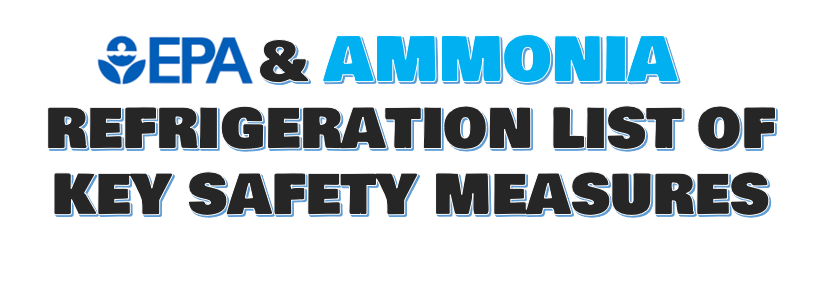EPA developed the following key safety measures for inspection of ammonia refrigeration systems and
reviewed them with the International Institute of Ammonia Refrigeration. These are measures that
EPA has determined should be in place, regardless of an ammonia refrigeration system’s age or size.
This is not intended to be a complete list of important safety measures but rather a subset of easily
verifiable items that could help facilities prevent ammonia releases and prepare for any releases that
do occur. This also does not replace the obligation to comply with EPA’s Risk Management Program,
found at 40 C.F.R. Part 68, or the Clean Air Act General Duty Clause.
Identifying Hazards
- Hazard Addressed: Releases or safety deficiencies that stem from a failure to identify hazards in
design/operation of system- Facility has completed a process hazard analysis or review
- Operating Activities:
- Hazard Addressed: High risk of release from operating or maintenance activity
- System has self-closing/quick closing valves on oil pots.
- Facility has written procedures for maintenance and operation activities.
- Only authorized persons have access to machinery room and the ability to alter safety settings on equipment.
- Hazard Addressed: High risk of release from operating or maintenance activity
- Maintenance/Mechanical Integrity:
- Hazard Addressed: Leaks/releases from maintenance neglect
- A preventative maintenance program is in place to, among other things, detect and control corrosion, deteriorated vapor barriers, ice buildup, and pipe hammering, and to inspect integrity of equipment/pipe supports.
- All piping system openings except the relief header are plugged or capped, or valve is locked.
- Equipment, piping, and emergency shutdown valves are labeled for easy identification, and pressure vessels have legible, accessible nameplates.
- All atmospheric pressure relief valves have been replaced in the last five years with visible confirmation of accessible pressure relief valves [note – replacement every five years is the general rule but there are two other options in IIAR Bulletin 110, 6.6.3]
- Machinery Room and System Design
- Hazard Addressed: Inability to isolate and properly vent releases
- The System(s) has/have emergency shut-off and ventilation switches outside each machinery room.
- The machinery room(s) has/have functional, tested, ventilation. Air inlets are positioned to avoid recirculation of exhaust air and ensure sufficient inlet air to replace exhausted air.
- Documentation exists to show that pressure relief valves that have a common discharge header have adequately sized piping to prevent excessive backpressure on relief valves, or if built prior to 2000, have adequate diameter based on the sum of the relief valve cross sectional areas.
- Emergency Actions
- Hazard Addressed: Inability to regain control and reduce release impact
- Critical shutoff valves are accessible, and a schematic is in place to show responders where to access them.
- EPCRA Tier II reporting is up to date.
- Additional Compliance Items
- Identifying Hazards
- For systems that employ hot gas defrost, the process hazard analysis/review includes an analysis of, and identifies, the engineering and administrative controls for the hazards associated with the potential of vapor propelled liquid slugs and condensation-induced hydraulic shock events.
- Operating Activities and Maintenance/Mechanical Integrity
- Written procedures are in place for proper use and care of personal protective equipment.
- If respirators are used, facilities know the location of their respirators, and they are inspected and maintained per manufacturer or industry standards.
- All changes to automation systems (programmable logic controls and/or supervisory control and data acquisition systems) if present, are subject to management of change procedures.
- Machinery Room and System Design
- The facility has engineering controls in place to protect equipment and piping against overpressure due to hydrostatic expansion of trapped liquid refrigerant. Administrative controls are acceptable where hydrostatic overpressure can occur only during maintenance operations.
- Eyewash station(s) and safety shower(s) is/are present and functional. Emergency Actions
- Emergency response communication has occurred or has been attempted with the Local Emergency Planning Committee and local responders.
- The facility has an emergency action plan pursuant to 29 C.F.R. § 1910.38(a) or an emergency response plan pursuant to 29 C.F.R. § 1910.120(q) and 40 C.F.R. § 68.95.
- Identifying Hazards

